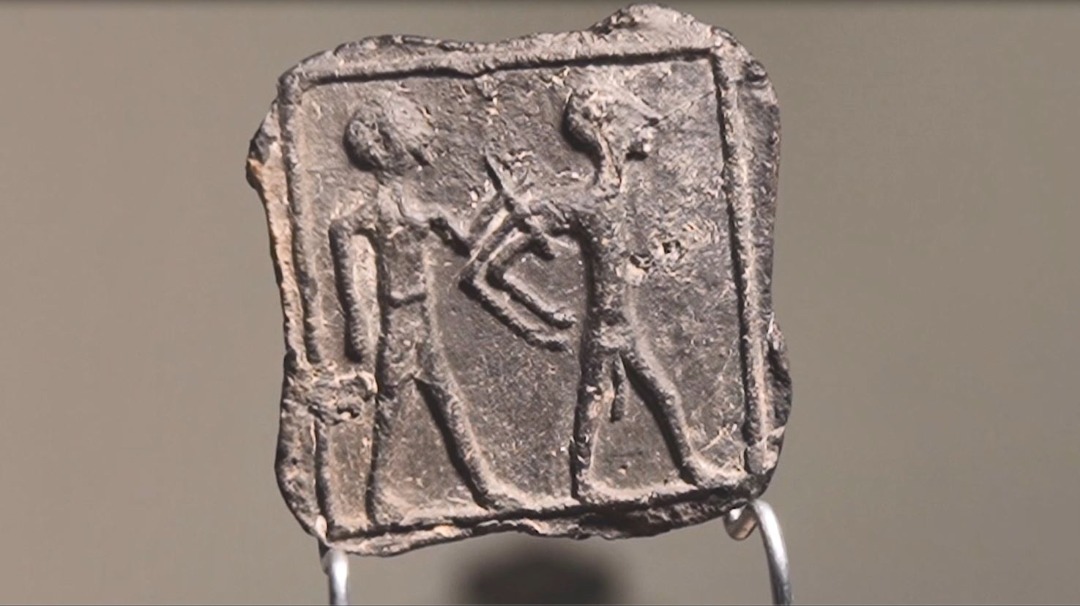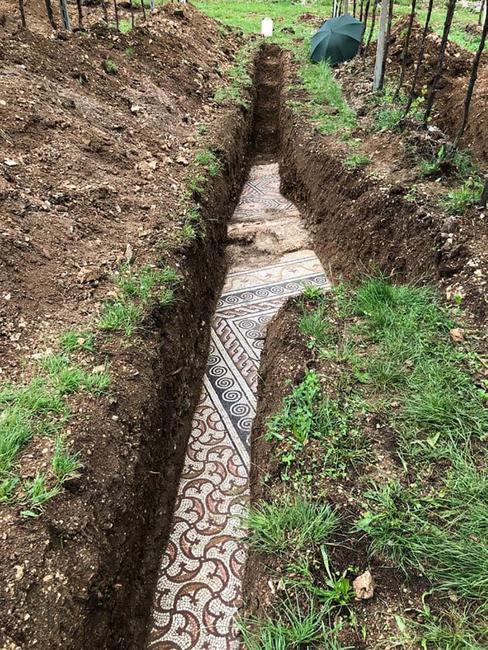Ancient Israelites Used Cannabis as Temple Offering
Jonathan Kantrowitz at Archaeology News Report - 15 hours ago
The ancient Israelites used cannabis in their religious rituals, archaeologists were stunned to learn by analyzing charred residues on a 2,700-year-old altar unearthed in a desert shrine. Complete article The weed traces were found on one of the altars that once stood in the temple at Tel Arad, in Israel’s Negev desert. The cannabinoid substance was likely burned to deliberately get worshippers high on the drug’s psychoactive compounds, researchers have concluded.
Israeli boy discovers ancient Caanaite tablet during family trip in southern Israel
Jonathan Kantrowitz at Archaeology News Report - 15 hours ago

A six-year-old Israeli boy discovered a 3,500-year-old tablet during a visit to the site of an archaeological site in the Negev desert. Imri Elya from Kibbutz Nirim found the artifact at Tel Jemmah, and turned it over to the National Treasures Department of the Israel Antiquities Authority. The 1.1-inch by 1.1-inch clay tablet is engraved with a depiction of a man wearing a skirt leading a naked captive whose hands are tied behind the back. The tablet seems to indicate ethnic differences between captor and captive; the captor’s hair is curled and his face is full, while the captiv... more »
Who were the Canaanites? New insight from 73 ancient genomes
Jonathan Kantrowitz at Archaeology News Report - 1 day ago

\ SHARE PRINT E-MAIL [image: IMAGE] IMAGE: THIS IMAGE SHOWS A GENERAL VIEW OF THE TEL MEGIDDO SITE. view more CREDIT: COURTESY OF THE MEGIDDO EXPEDITION The people who lived in the area known as the Southern Levant--which is now recognized as Israel, the Palestinian Authority, Jordan, Lebanon, and parts of Syria--during the Bronze Age (circa 3500-1150 BCE) are referred to in ancient biblical texts as the Canaanites. Now, researchers reporting in the journal *Cell* on May 28 have new insight into the Canaanites' history based on a new genome-wide analysis of ancient DNA collected... more »
Human mobility and Western Asia's early state-level societies
Jonathan Kantrowitz at Archaeology News Report - 1 day ago

Archaeogenomic analysis of Anatolia, Northern Levant and the Southern Caucasus sheds light on population dynamics from the Neolithic to Bronze Age, as peoples transitioned from farming to pastoralist communities and early state-level societies MAX PLANCK INSTITUTE FOR THE SCIENCE OF HUMAN HISTORY SHARE PRINT E-MAIL [image: IMAGE] IMAGE: ABOVE: COPPER-SILVER DIADEM WITH TRANSCAUCASIAN CONNECTION FROM THE ROYAL TOMB IN ARSLANTEPE, EASTERN TURKEY. BELOW: MESOPOTAMIAN-RELATED POTTERY IN ARSLANTEPE (PALACE PERIOD) view more CREDIT: MISSIONE ARCHEOLOGICA ITALIANA NELL'ANATOLIA ORIENT... more »
4,000 years of contact, conflict & cultural change had little genetic impact in Near East
Jonathan Kantrowitz at Archaeology News Report - 1 day ago
Only three periods had lasting effect on genetics of local people in Beirut WELLCOME TRUST SANGER INSTITUTE SHARE PRINT E-MAIL The Near East was a crossroad for the ancient world's greatest civilizations, and invasions over centuries caused enormous changes in cultures, religions and languages. However, a new study of the DNA of ancient skeletons spanning 4,000 years has revealed that most of these changes had no lasting effect on the genetics of the local population of Beirut. Whilst the invasions and conquests may have been revolutionary for the elite rulers, researchers at t... more »
Genomic analysis shows long-term genetic mixing in West Asia before world's first cities
Jonathan Kantrowitz at Archaeology News Report - 1 day ago

International team provides some of the earliest genetic glimpses at the movement and interactions of populations in West Asia 8,500 years ago HARVARD UNIVERSITY SHARE PRINT E-MAIL [image: IMAGE] IMAGE: A PARTIAL MAP OF WEST ASIA, WHICH INCLUDES ANATOLIA (PRESENT-DAY TURKEY), THE NORTHERN LEVANT, AND THE SOUTHERN CAUCASUS. AN INTERNATIONAL TEAM OF RESEARCHERS SHOWED POPULATIONS FROM ANATOLIA AND THE CAUCASUS... view more CREDIT: IMAGE COURTESY OF THE MAX PLANCK-HARVARD RESEARCH CENTER FOR THE ARCHAEOSCIENCE OF THE ANCIENT MEDITERRANEAN New research on one history's most importa... more »
Material and genetic resemblance in the Bronze Age Southern Levant
Jonathan Kantrowitz at Archaeology News Report - 1 day ago

UNIVERSITY OF VIENNA SHARE PRINT E-MAIL [image: IMAGE] IMAGE: GENERAL OF MEGIDDO view more CREDIT: © DR ISRAEL FINKELSTEIN, TEL AVIV UNIVERSITY A team around Ron Pinhasi at the University of Vienna carried out a detailed analysis of ancient DNA of individuals from the Bronze Age Southern Levant known as 'Canaanites', to provide insights on the historical and demographic events that shaped the populations of that time and area. The scientists aimed at answering three basic questions: How genetically homogenous were the people from the Bronze Age Southern Levant, what were their... more »
Ear infections discovered in remains of humans living in levant 15,000 years ago
Jonathan Kantrowitz at Archaeology News Report - 3 days ago
Tel Aviv University findings indicate that ear infections in the region peaked some 6,000 years ago due to high population density, poor hygiene and cold and rainy climate conditions AMERICAN FRIENDS OF TEL AVIV UNIVERSITY SHARE PRINT E-MAIL Researchers at Tel Aviv University have discovered evidence of ear infections in the skull remains of humans living in the Levant some 15,000 years ago. "Our research seeks to determine the impact of our environment on illnesses in different periods," says lead author Dr. Hila May of the Department of Anatomy and Anthropology at TAU's Sackl... more »
The emergence and spread of the house mouseover the last 20,000 years, from the Middle East to Europe 4,000 years ago
Jonathan Kantrowitz at Archaeology News Report - 1 week ago
Like humans, the house mouse, or *Mus musculus* sp., is widespread throughout the world, making it the most invasive rodent species. An international study involving eight countries* and led by Thomas Cucchi of the 'Archaeozoology, Archaeobotany: Societies, Practices and Environments' laboratory (CNRS/Muséum national d'Histoire naturelle) reveals how human activities have favoured the emergence and spread of this animal over the last 20,000 years, from the Middle East to Europe 4,000 years ago. To reconstruct the history of the biological invasion of the house mouse, the researcher... more »
- A unique subterranean system hewn in the bedrock from the Second Temple period
Jonathan Kantrowitz at Archaeology News Report - 1 week ago
the Israel Antiquities Authority and the Western Wall Heritage Foundation have revealed new and impressive archaeological discoveries uncovered under the lobby of the Western Wall Tunnels - A unique subterranean system hewn in the bedrock from the Second Temple period discovered beneath an impressive 1400-year-old public building. According to the Archaeologists this is the first time such a system has been uncovered near the Western Wall. This system, the first of its kind uncovered in the area of the Western Wall Plaza and Tunnels, was exposed in excavations conducted by the Israel... more »
The World's "Earliest-Known Temple" Was Built 11,500 Years Ago With Geometry In Mind
Jonathan Kantrowitz at Archaeology News Report - 2 weeks ago

Hunter-gatherers built colossal Göbekli Tepe 11,500 years ago in today's Turkey as a single structure of ritual significance, say Tel Aviv University researchers AMERICAN FRIENDS OF TEL AVIV UNIVERSITY SHARE PRINT E-MAIL [image: IMAGE] IMAGE: GÖBEKLI TEPE, ENCLOSURE C. view more CREDIT: GIL HAKLAY/AFTAU. The sprawling 11,500-year-old stone Göbekli Tepe complex in southeastern Anatolia, Turkey, is the earliest known temple in human history and one of the most important discoveries of Neolithic research. Researchers at Tel Aviv University and the Israel Antiquities Authority have... more »
Rare Coin from Bar-Kochba Revolt Discovered at the Foot of the Temple Mount
Jonathan Kantrowitz at Archaeology News Report - 2 weeks ago
A rare coin from the from Bar-Kochba Revolt, the Jews’ revolt against the Roman Empire in 132-136 CE, was recently discovered by Israeli archeologists at the foot of the Temple Mount, north of the City of David. The rare bronze coin, discovered in the course of archaeological excavations carried out by the Israel Antiquities Authority (IAA) in the William Davidson Archaeological Park, is decorated with a cluster of grapes and the inscription “Year Two of the Freedom of Israel,” and the reverse side features a palm tree and the inscription “Jerusalem.” This is the only coin from t... more »
















